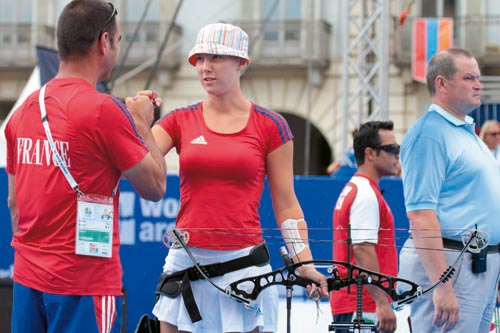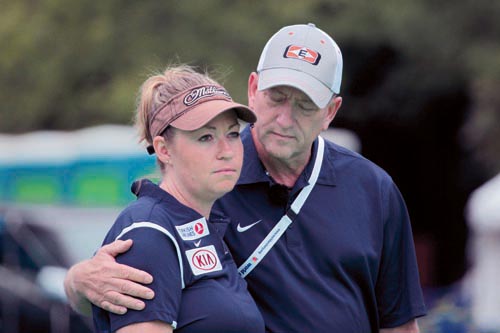I was recently talking to the manager of an international sports team, who said an athlete should be able to ignore negative thoughts, put them out of their mind, and get on with it. My response was a sage nodding of my head while inside my head, I was thinking, “wow.” This was not, I stress, at the insightful nature of the comment, but at its simplicity.
No well-rounded adult can ignore negative thoughts; they can only apply a simple analysis to see if they can be overcome. To picture this concept, imagine you wanted to buy something and went to the cash machine to look at your bank balance. This provides you with knowledge and gives you a decision to make, depending on how much or how little the cash machine states you have available:
- I have the funds to cover this and my other responsibilities, so I can go for it.
- I could afford this, but it will leave me no funds to cover an unexpected expense, so I will think about it.
- I do not have the funds to cover this, so at present I can not buy it.
Let us look at the third option, as it seems as cut and dried as the first. Surely any sensible person would look at the resources they have and, if they see that they could not proceed, then perhaps they would decide to save up to buy the item later. Similarly, no sane person would respect the individual who went into debt to make the purchase. However we are often being asked, as performers, to do exactly that. We are asked to just close our eyes and go into debt and ignore the consequences, being encouraged that it is the right thing to do and we should not worry about the way this makes us feel. In the example I have given, the person who advised you to go into debt would not be viewed as wise or helpful, but in the performance sphere the glib, “Go for it, you can do it” is counted as positive and useful advice. In fact, the performer with doubts is told they are being negative and even cowardly, and they must push on through this barrier. The more fantastic thing is that they are expected to continue to take the advice of the individuals who have helped put them in a situation they don’t want to be in. If it does not turn out well they are led to believe that, at best, it will be alright next time and, at worst, that they have failed. In this sense, we are being asked to gamble with a precious and fragile commodity – our self esteem.
 The second option is a situation that many well-practised performers find themselves in often: where they think ‘resources are tight, I could go for it or I could save up and buy it later.’ Here the performer is right at their limit and if anything unforeseen happens they will have no resources to deal with the situation, but they can still make an informed decision. It is unlikely that anything else will come around requiring their resources, and so they can cover it with the thought that, ‘It might be tight but it is worth it.’ This is the position that a top performer can deal with, this is what they practice for, and in goal-setting terms, it is an attainable goal that has an intrinsic value for the athlete.
The second option is a situation that many well-practised performers find themselves in often: where they think ‘resources are tight, I could go for it or I could save up and buy it later.’ Here the performer is right at their limit and if anything unforeseen happens they will have no resources to deal with the situation, but they can still make an informed decision. It is unlikely that anything else will come around requiring their resources, and so they can cover it with the thought that, ‘It might be tight but it is worth it.’ This is the position that a top performer can deal with, this is what they practice for, and in goal-setting terms, it is an attainable goal that has an intrinsic value for the athlete.
The individual, who is in option two in the original example, may choose to ‘save up for it’, and this is when the performer thinks to themselves, ‘this is just too difficult, so I will back out of it and prepare better for it next time.’ This choice would be viewed as admirable and mature in the example I have given, and takes great bravery. However in the performance sphere it may be viewed, paradoxically, as cowardly. Here, the coach must be careful and understand their athlete, maybe they should encourage them and maybe they should respect their decision. This is when a coach requires insight into the individual performer’s psyche. It is important to remember that no one rule covers all; some archers will need nudging, while others will feel unnecessarily pressured and uncomfortable. Because the resources are available, but tight, it is all about how much the individual wants the thing.
The first option is the ideal that every performer should work towards: ‘I can easily cover the price of what I want, and I am comfortable with that decision.’ When preparing a performance schedule, the individual should always have some events planned that almost seem beneath them, so that they can perform in this state, with plenty of ‘cash in the bank.’ The results achieved allow the performer to ‘bank’ some self esteem credit, and allows them to perform better and to a higher level in more stressful situations.
 To go back to the original comment from the team manager, I hope it is clear that dealing with situations that induce a negative set of thoughts requires the performer to be able to see what sort of self-esteem ‘balance’ they have to cover the situation. This means that an informed decision is made, and rather than ignoring the negative thoughts, they are dealt with in a way that makes it possible to recognise and face up to the issues.
To go back to the original comment from the team manager, I hope it is clear that dealing with situations that induce a negative set of thoughts requires the performer to be able to see what sort of self-esteem ‘balance’ they have to cover the situation. This means that an informed decision is made, and rather than ignoring the negative thoughts, they are dealt with in a way that makes it possible to recognise and face up to the issues.
Pushing yourself or being pushed by others into a situation of negative equity is dangerous. Sadly, in performance areas, many people respect the risk-taker, but would they respect someone who was running themselves into debt? Taking risks is useful in some situations, but a long- term future built on gambling what you don’t have is exhausting and dangerous. A culture of gambling everything, and more, on one throw of the dice is not going to give stability. The balance between perceived negativity and positivity is important to get right, as it allows the performer to exist in an exciting and challenging atmosphere where they can learn and perform safely.




Hermes Replica…
What a stuff of un-ambiguity and preserveness of valuable knowledge regarding unexpected emotionsChecks and balances | Bow International….